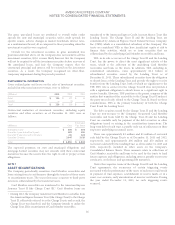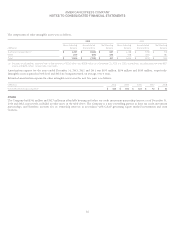American Express 2013 Annual Report Download - page 90
Download and view the complete annual report
Please find page 90 of the 2013 American Express annual report below. You can navigate through the pages in the report by either clicking on the pages listed below, or by using the keyword search tool below to find specific information within the annual report.
AMERICAN EXPRESS COMPANY
NOTES TO CONSOLIDATED FINANCIAL STATEMENTS
all dividends paid by ICBC, as well as ongoing hedge costs. The TRC
matures on August 1, 2014.
Derivatives may give rise to counterparty credit risk, which is the
risk that a derivative counterparty will default on, or otherwise be
unable to perform pursuant to, an uncollateralized derivative
exposure. The Company manages this risk by considering the current
exposure, which is the replacement cost of contracts on the
measurement date, as well as estimating the maximum potential value
of the contracts over the next 12 months, considering such factors as
the volatility of the underlying or reference index. To mitigate
derivative credit risk, counterparties are required to be pre-approved
by the Company and rated as investment grade. Counterparty risk
exposures are centrally monitored by the Company. Additionally, in
order to mitigate the bilateral counterparty credit risk associated with
derivatives, the Company has in certain instances entered into master
netting agreements with its derivative counterparties, which provide a
right of offset for certain exposures between the parties. A significant
portion of the Company’s derivative assets and liabilities as of
December 31, 2013 and 2012 is subject to such master netting
agreements with its derivative counterparties. There are no instances
in which management makes an accounting policy election to not net
assets and liabilities subject to an enforceable master netting
agreement on the Company’s Consolidated Balance Sheets. To further
mitigate bilateral counterparty credit risk, the Company exercises its
rights under executed credit support agreements with certain of its
derivative counterparties. These agreements require that, in the event
the fair value change in the net derivatives position between the two
parties exceeds certain dollar thresholds, the party in the net liability
position posts collateral to its counterparty. All derivative contracts
cleared through a central clearinghouse are collateralized to the full
amount of the fair value of the contracts.
In relation to the Company’s credit risk, under the terms of the
derivative agreements it has with its various counterparties, the
Company is not required to either immediately settle any outstanding
liability balances or post collateral upon the occurrence of a specified
credit risk-related event. Based on the assessment of credit risk of the
Company’s derivative counterparties as of December 31, 2013 and
2012, the Company does not have derivative positions that warrant
credit valuation adjustments.
The Company’s derivatives are carried at fair value on the
Consolidated Balance Sheets. The accounting for changes in fair value
depends on the instruments’ intended use and the resulting hedge
designation, if any, as discussed below. Refer to Note 3 for a
description of the Company’s methodology for determining the fair
value of derivatives.
The following table summarizes the total fair value, excluding interest accruals, of derivative assets and liabilities as of December 31:
Other Assets
Fair Value
Other Liabilities
Fair Value
(Millions) 2013 2012 2013 2012
Derivatives designated as hedging instruments:
Interest rate contracts
Fair value hedges $ 455 $ 824 $2$—
Total return contract
Fair value hedge 8——19
Foreign exchange contracts
Net investment hedges 174 43 116 150
Total derivatives designated as hedging instruments 637 867 118 169
Derivatives not designated as hedging instruments:
Foreign exchange contracts, including certain embedded derivatives(a) 64 75 95 160
Total derivatives not designated as hedging instruments 64 75 95 160
Total derivatives, gross 701 942 213 329
Cash collateral netting(b) (336) (326) —(21)
Derivative asset and derivative liability netting(c) (36) (23) (36) (23)
Total derivatives, net(d) $ 329 $ 593 $ 177 $ 285
(a) Includes foreign currency derivatives embedded in certain operating agreements.
(b) Represents the offsetting of derivative instruments and the right to reclaim cash collateral (a receivable) or the obligation to return cash collateral (a payable) arising
from derivative instrument(s) executed with the same counterparty under an enforceable master netting arrangement. Additionally, the Company received noncash
collateral in the form of security interest in U.S. Treasury securities with a fair value of nil and $335 million as of December 31, 2013 and 2012, respectively, none of
which was sold or repledged. Such noncash collateral effectively further reduces the Company’s risk exposure to $329 million and $258 million as of December 31,
2013 and 2012, respectively, but does not reduce the net exposure on the Company’s Consolidated Balance Sheets. Additionally, the Company posted $26 million
and nil as of December 31, 2013 and 2012, respectively, as initial margin on its centrally cleared interest rate swaps not netted against the derivative balances.
(c) Represents the amount of netting of derivative assets and derivative liabilities executed with the same counterparty under an enforceable master netting
arrangement.
(d) The Company has no individually significant derivative counterparties and therefore, no significant risk exposure to any single derivative counterparty. The total net
derivative assets and derivative liabilities are presented within other assets and other liabilities on the Company’s Consolidated Balance Sheets.
88
























